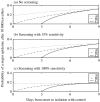Evaluation of measures to reduce international spread of SARS
- PMID: 16476169
- PMCID: PMC2870475
- DOI: 10.1017/S0950268806005863
Evaluation of measures to reduce international spread of SARS
Abstract
Mathematical models are used to quantify the effect of border control measures in reducing the international spread of SARS. Border screening is shown to play a relatively minor role in reducing disease spread. Assuming detection rates similar to those reported for arrival screening in Australia, screening can detect up to 10% (95% CI 3-23) of infected travellers, and reduce the probability of a large outbreak by up to 7% (95% CI 2-17). Rapid reductions in the time to diagnosis and effective facilities for the isolation of cases are essential to ensure that there will not be a large outbreak, and each week of delay in responding to imported infection approximately doubles the total number of cases. While the control response is being developed in a currently uninfected region, border screening can provide up to one week's additional time in which to improve methods for early isolation of cases.
Figures




References
-
- Hong Kong Department of Health http://www.sars-expertcom.gov.hk/english/reports/reports/reports_fullrpt.... http://www.sars-expertcom.gov.hk/english/reports/reports/reports_fullrpt... . SARS in Hong Kong: from experience to action 2006 ( ). Accessed 19 January 2006. - PubMed
-
- Health Canada http://www.phac-aspc.gc.ca/publicat/sars-sras/naylor/index.html. http://www.phac-aspc.gc.ca/publicat/sars-sras/naylor/index.html . Learning from SARS – renewal of public health in Canada 2006 ( ). Accessed 19 January 2006.
-
- Samaan G et al. Border screening for SARS in Australia: what has been learnt. Medical Journal of Australia. 2004;180:220–223. - PubMed
Publication types
MeSH terms
LinkOut - more resources
Full Text Sources
Medical
Miscellaneous

